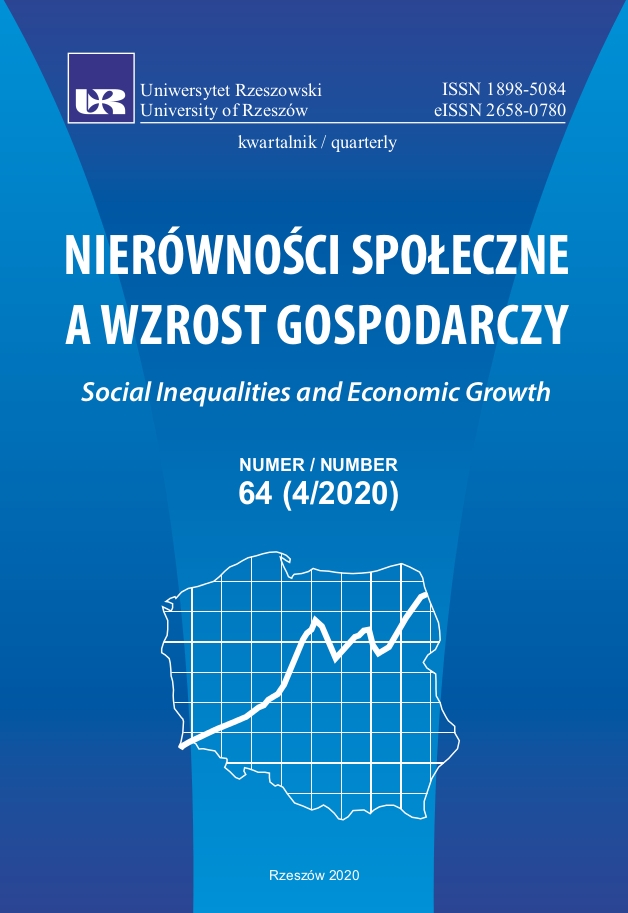Problemy zadłużenia publicznego Polski na tle krajów Unii Europejskiej
DOI:
https://doi.org/10.15584/nsawg.2020.4.2Słowa kluczowe:
dług publiczny Polski, przystąpienie do strefy euro, kierunki poprawy zdrowia finansów publicznychAbstrakt
Celem artykułu jest prezentacja głównych problemów obecnego zadłużenia Polski na tle kra-jów UE. Należy do nich zaliczyć: niski rating i wysokie koszty obsługi długu, wysoki poziom zadłużenia zagranicznego Skarbu Państwa, wysoki poziom deficytu podsektora rządu centralnego w ostatnich latach (z wyjątkiem 2018 r.), znaczny poziom zadłużenia SP w walutach obcych, w warunkach dużej zmienności kursów walutowych, brak długofalowej strategii długu, niespełnienie warunków wejścia do strefy euro, brak optymalizacji strategii długu w sensie ekonomicznym i inżynierii finansowej. Aktualna polityka finansowa, powodująca znaczny wzrost wydatków budżetowych w 2019 r. i w latach następnych, nie sprzyja rozwiązaniu tych problemów. Kierunek zadłużenia Polski w latach po kryzysie z 2008 r. nie jest zgodny z niekryzysowymi krajami UE, w szczególności w zakresie obniżenia rentowności długu i kosztów obsługi. Nie znajduje uzasadnienia brak terminu przystąpienia do strefy euro, tj. pozostawanie w nielicznej grupie krajów bez wspólnej waluty i z niskim poziomem PKB. Osiągnięcia Polski w zakresie redukcji zadłużenia w końcówce ubiegłego wieku oraz sytuacja krajów „zdrowych finansów publicznych” implikuje kierunki optymalizacji strategii zadłużenia. Wiele problemów wymaga działań w krótszym horyzoncie czasowym (ok. pięcioletnim): obniżenie długu (w relacji do PKB) do poziomu z 2000 r., uzyskanie ratingu co najmniej A+ (według S&P), osiągnięcie kosztów długu nieprzekraczających 1% PKB, podjęcie działań na rzecz przystąpienia do strefy euro.
Downloads
Bibliografia
Eurostat, baza danych. Pobrane z: https://ec.europa.eu/eurostst/data/database (2019.04.9).
Goczek, Ł., Mycielska, D. (2014). Gotowi na EURO? Badanie empiryczne faktycznej swobody polskiej polityki pieniężnej. Bank i Kredyt, 45(3), 267–270.
Gomułka, S. (2019). Ekonomiczne i polityczne implikacje pozostawania poza strefą euro. Nauka, 1, 7–29. DOI: 10.24425/nauka.2019.126177.
GUS. (2018). Komunikat dotyczący deficytu i długu sektora instytucji rządowych i samorządowych w 2017 r. Warszawa: GUS.
GUS. (2019). Komunikat dotyczący deficytu i długu sektora instytucji rządowych i samorządowych w 2017 r. Warszawa: GUS.
Jędrzejczyk, M. (2019). Teoretyczne dylematy akcesji Polski do strefy euro. Nierówności Społeczne a Wzrost Gospodarczy, 57,107–118. DOI: 10.15584/nsawg.2019.1.7.
Klukowski, L. (2018). Koncepcje nowelizacji ustawodawstwa ograniczającego dług publiczny i zarządzanie długiem. Nierówności Społeczne a Wzrost Gospodarczy, 54, 87–100. DOI: 10.15584/nsawg.2018.2.6.
Klukowski, L. (2019). Dług publiczny Polski – cele w średnim i długim horyzoncie. Nierówności Społeczne a Wzrost Gospodarczy, 57, 189–202. DOI: 10.15584/ nsawg.2019.1.12.
Ministerstwo Finansów. (2018). Strategia zarządzania długiem sektora finansów publicznych w latach 2019–2022. Warszawa: Ministerstwo Finansów.
NBP. (2018). Raport o inflacji. Warszawa: NBP.
NBP. (2019). Raport o inflacji. Warszawa: NBP. NBP. (2020). Międzynarodowa pozycja inwestycyjna Polski w 2019 r. Warszawa: NBP.
Roczniki Statystyczne Rzeczypospolitej Polskiej, kolejne wydania 2001–2018. Warszawa: GUS.
Ustawa z dnia 27 sierpnia 2009 r. o finansach publicznych (Dz.U. z 2009 r., nr 157, poz. 1240).
Pobrania
Opublikowane
Jak cytować
Numer
Dział
Licencja
Prawa autorskie (c) 2020 Uniwersytet Rzeszowski

Utwór dostępny jest na licencji Creative Commons Uznanie autorstwa – Na tych samych warunkach 4.0 Miedzynarodowe.


